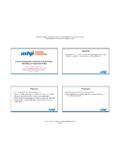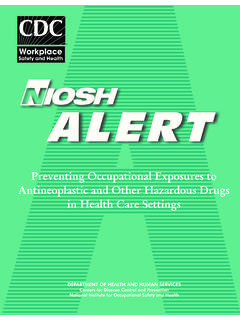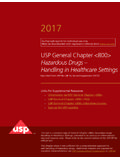Transcription of Hazardous Drugs and USP <800> - ASORN
1 6/7/2017. Hazardous Drugs and USP <800>. Seth Eisenberg RN OCN BMTCN. Financial Disclosure Seth Eisenberg is on the speaker's bureau for Becton Dickinson and ICU Medical, and consults with B Braun, Medtronic, Mobius Therapeutics and Baxter No off-label information will be presented 2. Objectives Describe the risks associated with Hazardous drug exposure Discuss current studies on environmental contamination utilizing wipe testing and urinary excretion Discuss the implications of USP <800>. 3. 1. 6/7/2017. Definition Hazardous Drugs (HDs) are defined by niosh (the National Institute for Occupational Safety and Health) as having one or more of the following characteristics: Carcinogenicity (causes cancer). Teratogenicity or other developmental toxicity (causes birth defects). Reproductive toxicity Organ toxicity at low doses Genotoxicity (causes genetic mutations).
2 Structure mimicking existing HDs (similar in chemical structure). No minimum acceptable levels of exposure to HDs has been established Connor, T, 2016 4. Acute risks associated with exposure Lightheadedness Nausea and vomiting Headache Local skin or mucous membrane reactions Dizziness Hair Loss Nasal sores Abdominal pain Contact dermatitis and eczema Valanis et al, 1993 5. Reproductive risks associated with exposure Congenital abnormalities Premature labor Spontaneous abortions Low-birth weight Menstrual cycle changes Miscarriages Infertility Learning disabilities in offspring Hemminki 1985; Stucker 1990; Shortridge 1995; Valanis 1997; Fransman 2007; Valanis 1999; Martin 2005; Ratner 2010 6. 2. 6/7/2017. Genotoxic risks associated with exposure Researcher Year Findings McDiarmid, M. et al 2010 Abnormalities in chromosome 5 in exposed vs non exposed personnel (p =.)
3 01). Ladiera, C. et al 2014 Elevated frequency of micronuclei in exposed vs non exposed personnel (p <.001). Moretti, M. et al 2015 Chromosomal aberrations in exposed vs non exposed (p <.0001). Elevated frequency of micronuclei in exposed vs non . exposed (p < .0001). 7. Cancer risks associated with exposure Known carcinogens Probable carcinogens Arsenic Azicitidine Busulfan Carmustine (BCNU). Chlorambucil Cisplatin Cyclophosphamide Doxorubicin Melphalan Mitomycin Thiotepa Nitrogen mustard Procarbazine Etoposide IARC Website: ; Retrieved 4/16/17 8. Environmental Contamination Recent studies continue to demonstrate widespread HD contamination in healthcare settings Researcher Year Findings Hon, C Y. et al 2013 36% of 438 wipe tests in pharmacy and administration areas were positive Areas included calculators, chairs, pens, printers keyboards and mouse Hon, C Y.
4 Et al 2014 20% of hand wipes (n=110 multidisciplinary staff) were positive Highest level was on staff who were not administering HDs Hon, C Y. et al 2015 55% of 201 urine samples (n=103) were positive Highest concentration in unit clerks and staff who were not administering HDs Viegas, S. et al 2014 37% of 327 wipe tests in pharmacy and administration areas were positive Areas included infusion pumps, tables and door handles 9. 3. 6/7/2017. Guidelines Versus Standards Guidelines = Recommendations Standards = Requirements Examples: Examples: niosh Department of Health ASHP CMS. ONS The Joint commission Not enforceable Are enforceable USP <800> will be enforced by each state's Board of Pharmacy or designated agency, CMS (under COPs), the FDA, and likely The Joint Commission 10. USP Chapter 800 (USP <800>). This chapter applies to all healthcare personnel who handle HD preparations and all entities that store, prepare, transport, or administer HDs ( , pharmacies, hospitals and other healthcare institutions, patient treatment clinics, physicians' practice facilities.)
5 USP <800> p. 1 11. USP <800>. Includes (but not limited to): Pharmacists Pharmacy technicians Nurses Physicians and physician assistants 12. 4. 6/7/2017. USP <800>. Does not provide information specific to the OR setting, or for performing ophthalmologic procedures Does not provide exemptions for HD use in other settings Harmonization between current ASORN guidelines and USP <800> will be required 13. USP <800> Requirements An Overview 14. USP <800> Requirements Hazardous drug List: Create a facility-specific list of Hazardous Drugs that is accessible by all staff List must be: Reviewed annually Updated when newly-approved HDs are incorporated into the practice setting 15. 5. 6/7/2017. USP <800> Requirements Training: Training must be provided to all staff who may have contact with HDs prior to initial work assignment, and annually thereafter Must cover: Summary of policies and procedures Proper use of PPE and other equipment ( , Closed System Transfer Devices).
6 Exposure response Managing spills Disposal of bags, tubing, syringes, and PPE. 16. USP <800> Requirements Hazard Communication Program: Establish policies and procedures to ensure worker safety Describe in writing how the standard will be implemented Provide training for all personnel who may be exposed to HDs prior to handling Obtain written confirmation that all personnel of reproductive capability understand the risks Photograph: 2017 S. Eisenberg associated with Hazardous Drugs 17. USP <800> Requirements HD Storage: HDs must be stored in an externally ventilated, negative-pressure room with at least 12 air changes per hour Refrigerated antineoplastic HDs must be stored in a dedicated refrigerator in a negative pressure area with at least 12 air changes per hour [ , storage room, buffer room, or containment segregated compounding area (C-SCA)].
7 18. 6. 6/7/2017. USP <800> Requirements HD Transport: The use of a pneumatic tube system is prohibited for transporting liquid HDs Must be transported in containers that can minimize breakage or leakage Photograph: 2017 S. Eisenberg 19. USP <800> Requirements Compounding: Sterile and nonsterile HDs must be compounded within a C-PEC ( biologic safety cabinet) located in a separate area (C-SEC). Photograph: 2017 S. Eisenberg 20. USP <800> Requirements Compounding: The C-SEC used for sterile and nonsterile compounding must: Be externally vented through high-efficiency particulate air (HEPA) filtration and physically separate from other preparation areas Have an appropriate air exchange per hour, and a negative pressure relative to all adjacent areas 21. 7. 6/7/2017. USP <800> Requirements Administration: Requires use of Closed System Transfer Devices (CSTDs).
8 When the dosage form allows. (p10, section 14). However, no distinction is made between the OR setting vs traditional infusion areas There is no accounting for workflow differences or how the HD. is being used 22. USP <800> Requirements Closed System Transfer Devices: A CSTD can be defined as a device that prohibits the transfer of environmental contaminants into the system and the escape of Hazardous drug or vapor concentrations outside the system. 1. There are 2 components to a CSTD: 1. A vial adaptor to prevent aerosols and vapors from escaping the vial 2. A device for transferring HD from the vial to the bag or directly to the patient 1 Connor, McLauchlan, & Vandenbroucke, 2007, p. 28. 23. USP <800> Requirements Closed System Transfer Devices: Are considered supplemental engineering controls and do not replace containment primary engineering controls ( , biologic safety cabinet) or personal protective equipment (PPE).
9 Although required for administration, CSTDs are recommended for compounding 24. 8. 6/7/2017. USP <800> Requirements Examples of CSTDs for transferring drug and administration: A. Corvida Halo B. BD Phaseal C. Equashield II. D. B Braun OnGuard E. ICU Medical ChemoLock F. ICU Medical Spiros G. BD/CareFusion Texium A B C D E F G. 25. USP <800> Requirements Personal Protective Equipment (PPE). Two pairs of ASTM 6978-05-tested chemotherapy gloves Cuffs must be long enough to cover the cuff of the gown Must not be worn >30 minutes unless otherwise noted by manufacturer Sterile chemotherapy gloves are available for OR use Photograph: 2017 S. Eisenberg 26. USP <800> Requirements Personal Protective Equipment (PPE): Chemotherapy-resistant gown Single-use and disposable Solid front and closable in the back Elastic or knit cuffs Must be able to resist HD permeability Sterile chemotherapy-resistant gowns are available There are currently no standards for gowns; ask the manufacturer for testing information Photograph: 2017 S.
10 Eisenberg 27. 9. 6/7/2017. USP <800> Requirements Personal Protective Equipment (PPE): Appropriate eye and face protection must be worn when there is a risk of splashing (p 7, section ). Specifically uses OR as an example When required, goggles must be used for eye protection as face shields alone are not considered adequate Shoe covers worn in areas where HDs are handled must be removed prior to leaving the area USP <800> Requirements Disposal: All PPE used in handling of HDs is considered trace contaminated and must be disposed of in properly labelled HD waste containers (normal trash not allowed). Photograph: 2017 S. Eisenberg USP <800> Requirements Cleaning: USP <800> differentiates between deactivation, decontamination, cleaning and disinfection Cleaning Step Purpose Comments Deactivation To make HD inactive Includes products containing peroxide, bleach, etc.






